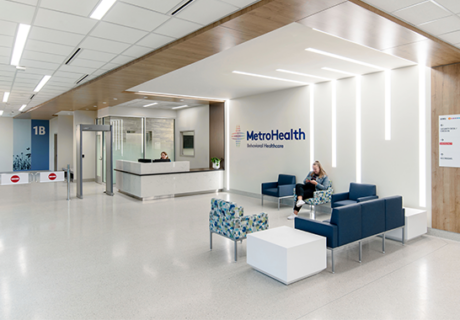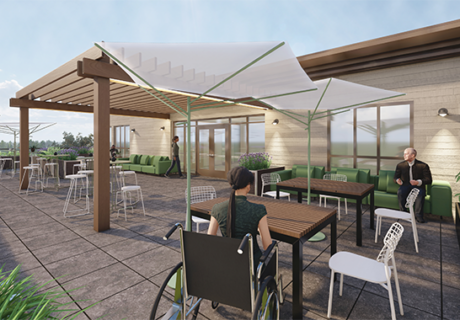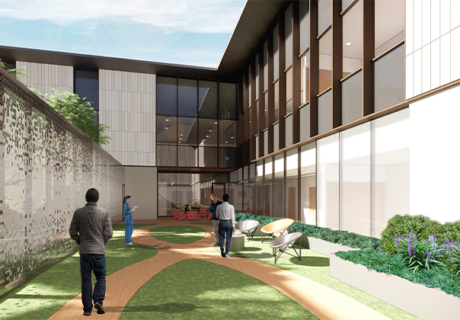Merrifield Center Brings Behavioral Healthcare Under One Roof
Separating service lines and population types is a common practice in behavioral healthcare for a number of reasons: safety and privacy concerns, differing treatment approaches, and a concerted effort to avoid institutional-feeling, big-box environments among them. Yet almost a decade ago, Fairfax County, Va., decided to bring its far-flung behavioral services under one roof. Cost-saving demands—as they do with everything relating to facility planning and growth these days—played a big role in this decision. But it was more than that. Much more, in fact.
Completed in late 2014 and occupied in March 2015, Merrifield Center in Fairfax, Va., serves more than 1.1 million residents in a 407-square-mile radius. The design of the new-build, 200,000-square-foot project relied on an unusually tight collaboration among the county and local design firms Noritake Associates (architecture), Huelat Davis Healing Design (interiors), and Rhodeside & Harwell (landscape architecture), all based in Alexandria, Va.
Among its notable features, Merrifield includes an emergency and crisis service center that not only provides emergency care for individuals with severe behavioral issues, but also incorporates a law enforcement outpost of sorts, where specially trained officers can divert individuals for psychiatric evaluation—rather than send them straight to jail—when warranted.
On the floors above the crisis center, the Merrifield facility houses an alternative school for kids with behavioral issues, a community health clinic and dental clinic, and myriad programs for adults and children across the spectrum of low- to high-risk needs. At the outset of the project, the design team set out to explore how other facilities around the country dealt with this kind of broad colocation of outpatient services in a nurturing, safe, and respectful way.
But they didn’t get very far. They couldn’t find any.
The lay of the land
The product of a land swap deal with nearby Inova Hospital, Merrifield Center developed into its current iteration after years of healthcare industry evolution and the ticking clock of expiring leases for many of Fairfax County’s behavioral healthcare offices. “We wanted to get out of seven or so leases at locations across the county and to consolidate as many of our services as we could into one facility,” says Will Williams, director of alcohol and drug services for Fairfax-Falls Church Community Services Board (CSB) and the county’s main representative on this eight-year project. “It wasn’t only to save money, but also so these services were more accessible for residents.”
The existing clinics were in rough shape. “A lot of them were really third-class facilities,” says Rae Noritake, principal of Noritake Associates. “They were very cramped and outdated.” Originally, 24 programs were under consideration to colocate at the new building; in the end, 13 were brought in, with room to add more later. The building’s footprint had already been determined before Noritake et al. were hired, because Inova Hospital was originally going to design and run the facility for the county. So when the county decided to take over the project itself in 2009, the new design team scrutinized the site plan from all angles.
“We had about six months’ worth of meetings with staff and with the architects to discuss our needs,” Williams says. “We met with user groups, too. The biggest thing was that it had to be a welcoming, healthy environment that was secure. We talked about interiors, the types of people we serve. We wanted a place that was flexible and that could be expanded. And we wanted something bright and sunny and welcoming, using the best practices of healthcare standards today.”
Practically speaking, the design team needed to reduce redundancies and costs for the county, fitting everything it could into the predetermined four-story space. As team members toured different clinics and offices scattered across the county, a few opportunities became clear. “Every department had had its own waiting room, lobby, and reception,” Noritake says. “All of those are now in a central location [on each floor]. So the center of the building is where the elevator cores are, and the most-public spaces in the building.”
Therapy and group rooms are now shared, as well, and are located right off the waiting rooms on the building’s main treatment floors. Doctors’ offices and staff workspaces were placed around the periphery along with an outboard stairway, affording staffers their own private, vertical access to anywhere in the building.
The programs on each floor were carefully considered and largely dictated by security issues. The basement, which houses the emergency department and men’s program, serves the highest-risk population and operates almost as a separate building in terms of access. The first floor is the most public space; from there, the risk level essentially gets lower the higher you go up. The floors are separated into east and west wings, where population groups can be further separated.
Barbara Huelat, interior design principal at Huelat Davis Healing Design, recalls the process of trying to set up site visits to peer facilities in advance of the Merrifield project. “We couldn’t find any. None. What made this unique was that it was all behavioral health outpatient services that had been in smaller facilities,” she says. “The only thing we found that was similar was the VA, but even then there was nothing that was just outpatient and of this size, combining this many groups, including children.”
Diversion first
The decision to bring a high-risk emergency department into this building wasn’t made lightly, and security and safety were top priorities.
“The bottom floor has its own entrance that does not mix with the public entrance on the floor above,” says Huelat. In addition—and this is another key differentiator for the Merrifield model—it includes its own sally port (a controlled, highly secure entrance where police vehicles can bring in someone they’ve detained), holding areas, and other spaces designed specifically to deal with high-risk individuals in need of psychiatric evaluation.
“If there’s an incident of a person behaving badly, someone who obviously has some sort of psychiatric disorder, in most counties they’d go to a hospital ED and then to the police station,” Noritake explains. “In Fairfax County, they’d be sent here. It’s almost like a police substation, with a specially trained officer on duty who takes over and writes a report, and the patient is under police control until they’re diagnosed by facility staff.” The goal, adds Huelat, “is to keep a lot of these people out of jail and get them safely into a rehab or treatment program.”
A local champion for this kind of program—dubbed Diversion First—is Creigh Deeds, a Virginia state senator, with whom the county has been working to promote more progressive mental health approaches. In 2013, Deeds was critically wounded when he was stabbed multiple times by his 24-year-old son, who then shot himself to death. Deeds’ son had been ordered by a judge to be committe
d for psychiatric treatment days before his attack on Deeds—but no available hospital bed could be found, and he was released home instead.
d for psychiatric treatment days before his attack on Deeds—but no available hospital bed could be found, and he was released home instead.
“This gives us a great, great opportunity to reduce the stigma of mental health,” says CSB’s Williams. “The department is working perfectly. If someone is suffering from acute mental illness or a severe substance abuse problem, they can be brought here. They’re not put in with the main population, so there’s little opportunity for someone else to be involved and maybe exacerbate the problem. We have 23-hour beds where we can modulate their medication, stabilize them, and, if they need additional care or hospitalization, we can refer them.”
Not all emergency patients are brought in under police custody, and Williams has seen a remarkable difference for these individuals, as well. “Even the most distressed persons come here and find solace,” he says. “People may be in a psychotic state, and if they come into a place that’s dreary, that’s dark, that looks like an institution—this may hinder recovery. But now, they come into a bright place. There’s good lighting, which seems to really play an important part. They can sit in emergency services, see this very welcoming design. There’s a place where kids can play, where moms and dads don’t have to worry about little kids when they’re trying to help a loved one. There are people down there to keep an eye on things, peer workers to help intercede.
“It’s almost night and day,” Williams says. “It has reduced the number of [violent] incidents and we’re able to do more for these folks.”
A natural order
The unique programming within the building is wrapped, inside and out, in a nature-driven design theme built on the concept of fractals. “Fractals are the basic geometry of organic design,” says Huelat. “They’re formed by nature, and they change in scale. Think about the leaf of a tree, and how it repeats the shape of the tree as a whole: You’ll see the center stem of the leaf and [its veins] branch out from there, and then you see the shape of the tree, with its trunk and branches.”
People, Huelat continues, tend to choose organic pathways. “We don’t live and work in a grid naturally; we’re inclined to follow nature’s path. It’s that premise that created the geometry for this building.”
Huelat, Noritake, and Kevin Fisher, principal and landscape architect with Rhodeside & Harwell, started with a bird’s-eye view of the site plan, looking at where the building would sit in relation to the planned parking garage and then charting points between them and plotting out scalability.
“We developed these interconnecting loop paths that circulate around the site as a whole and connect the upper site to the lower site,” Fisher says. “And they actually pass through the central space of the building.”
Bringing nature indoors was Huelat’s main directive to create healing spaces, and as such, the looping paths influenced not only the landscape but the architecture and interiors choices. Says Fisher, “More so than most other projects, I had a lot of meeting time with Barbara as well as the architect. I think the three of us together really came up with an indoor/outdoor kind of space.”
The intersecting curves that cut through the lobby of the building are asserted in the ceiling, along the floor, and in the lighting. “To take that further, we took the terrazzo materials that Barbara wanted to use on the interiors, and we matched precast concrete pavers to the colors as much as we could,” Fisher says.
Nature finds its way through all the floors via earthy tones and vibrant color accents (a different color scheme for each floor), along with bold, wall-sized graphic images of flora, particularly in the public spaces. This design choice, Huelat says, was born out of necessity. “The county didn’t give us any art budget,” she says. “So we integrated all graphic and design elements into the construction, through graphic design.”
Outside, the landscape includes subtle spaces for individuals to gather—or retreat—as necessary, whether it’s a caregiver taking a break or a small therapy group looking for a change of scenery. Still, every area surrounding the building is fully visible from inside. “We wanted to make sure the site felt safe for everyone, because it’s a mix of populations,” Fisher says. “It’s well lit, it’s highly visible, and all the landscaped spaces connect to multiple entrances.”
Despite some initial concerns from both staff and users about losing the independent, cozy nature of their previous workplaces, Williams is emphatic about the results and how the community has responded. “They love it!” Williams says. “People are happy, they’re proud to come into this building now. Our compliance rate went up. Incidents are way down.” He adds that they’ve received many queries from other systems interested in Merrifield’s model, and notes that Fairfax County plans to replicate many of the building’s strategies in other projects in the works.
“We brought consumers to the building, to give them a tour before it opened, and one of the best things that came back from that was: ‘You heard what we said,’” Williams recalls. “That right there really sealed it for us. We were on the right track.”




